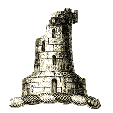Les Médiévales de Domfront
22ème édition
1, 2, 3 août 2025


Un peu d'Histoire
Il était une fois Domfront ...

GUILLAUME LE CONQUÉRANT
Entre 1048 et 1052 Geoffroy II Martel, comte d'Anjou, tenta de contrôler la région. Sa tentative provoqua la réplique de Guillaume le Bâtard, duc de Normandie (futur Conquérant), qui vint assiéger et prendre le château, confisqué de facto aux Bellême. La contrée, le Passais, fut annexée à la Normandie ; c'est la partie du duché qui est devenue le plus tardivement normande. Sur le plan religieux, elle continua à dépendre jusqu'à la révolution de l'évêché du Mans.
HENRI Ier BEAUCLERC, SEIGNEUR DE DOMFRONT
En 1087, à la mort du Conquérant, Robert II de Bellême chassa la garnison ducale et reprit le château. Ordéric Vital, chroniqueur partial, le décrit comme un tyran. Il semble que la population de Domfront se révolta contre lui en 1092, et se donna à Henri, 3e fils de Guillaume le Conquérant, qui n'avait pas reçu de domaines lors de la succession de son père. Ce fut l'origine de la fortune de Domfront au XIIe siècle et au-delà, car peu de temps après, en 1100, à la mort de son frère Guillaume le Roux, Henri Beauclerc devint roi d'Angleterre, puis duc de Normandie en 1106 après sa victoire contre son autre frère Robert Courteheuse à la bataille de Tinchebray, non loin de Domfront. Il avait ainsi reconstitué le domaine de son père. Dès lors, le seigneur de Domfront n'était autre que le duc-roi. Puissant et riche, il remodela complètement le château, agrandit son enceinte et fit construire, peut-être vers 1120, l'énorme donjon dont il reste encore des vestiges. Ce fut également une période de prospérité pour l'abbaye de Lonlay, qui reconstruisit son église abbatiale (il subsiste de cette époque le transept et ses intéressantes séries de chapiteaux), et ses prieurés : Saint-Michel de Goult, et surtout à Domfront Saint-Symphorien, situé dans l'enceinte du château, et Notre-Dame-sur-l'Eau, en contrebas de l'éperon.

